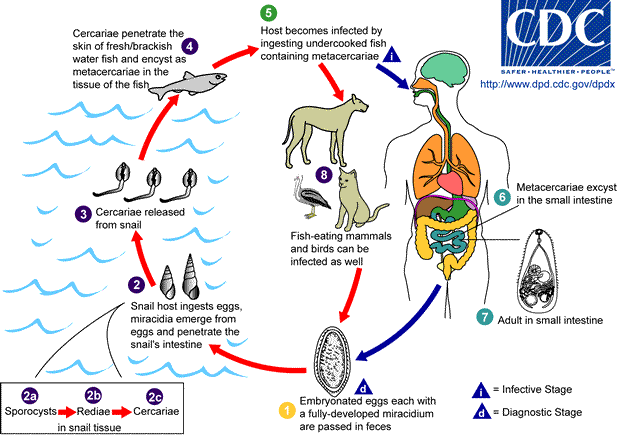Heterophyidae on:
[Wikipedia]
[Google]
[Amazon]
Heterophyidae is a
family
Family (from la, familia) is a group of people related either by consanguinity (by recognized birth) or affinity (by marriage or other relationship). The purpose of the family is to maintain the well-being of its members and of society. Idea ...
of intestinal
The gastrointestinal tract (GI tract, digestive tract, alimentary canal) is the tract or passageway of the digestive system that leads from the mouth to the anus. The GI tract contains all the major organs of the digestive system, in humans and ...
trematodes
Trematoda is a class of flatworms known as flukes. They are obligate internal parasites with a complex life cycle requiring at least two hosts. The intermediate host, in which asexual reproduction occurs, is usually a snail. The definitive host ...
in the order Plagiorchiida
Plagiorchiida is a large order of trematodes, synonymous to Echinostomida. They belong to the Digenea, a large subclass of flukes. This order contains relatively few significant parasites of humans.
The following families are placed here, organ ...
.
Description: " Tegument covered by spines. Oral sucker
Sucker may refer to:
General use
* Lollipop or sucker, a type of confection
* Sucker (slang), a slang term for a very gullible person
* Hard candy
** Cough drop
** Mint (candy)
Biology
* Sucker (botany), a term for a shoot that arises undergro ...
not armed or armed by cyrcumoral spines. Pharynx
The pharynx (plural: pharynges) is the part of the throat behind the mouth and nasal cavity, and above the oesophagus and trachea (the tubes going down to the stomach and the lungs). It is found in vertebrates and invertebrates, though its st ...
presented. Genital synus presented. Ventral and genital suckers usually not combined. Cirrus
Cirrus may refer to:
Science
*Cirrus (biology), any of various thin, thread-like structures on the body of an animal
*Cirrus (botany), a tendril
* Infrared cirrus, in astronomy, filamentary structures seen in infrared light
*Cirrus cloud, a typ ...
and bursa absent. Two testes
A testicle or testis (plural testes) is the male reproductive gland or gonad in all bilaterians, including humans. It is homologous to the female ovary. The functions of the testes are to produce both sperm and androgens, primarily testoste ...
located in posterior part of the body. Vitellaria
''Vitellaria paradoxa'' (formerly ''Butyrospermum parkii''), commonly known as shea tree, shi tree (), or vitellaria, is a tree of the family Sapotaceae. It is the only species in the genus ''Vitellaria'',intermediate hosts are molluscs of 
Prosobranchia
Prosobranchia was a large taxonomic subclass of sea snails, land snails and freshwater snails. This taxon of gastropods dates back to the 1920s. It has however been proven to be polyphyletic (consisting of more than one lineage of descent). Gen ...
, second intermediate hosts are fish
Fish are aquatic, craniate, gill-bearing animals that lack limbs with digits. Included in this definition are the living hagfish, lampreys, and cartilaginous and bony fish as well as various extinct related groups. Approximately 95% of ...
es. Definite hosts are bird
Birds are a group of warm-blooded vertebrates constituting the class Aves (), characterised by feathers, toothless beaked jaws, the laying of hard-shelled eggs, a high metabolic rate, a four-chambered heart, and a strong yet lightweig ...
s and mammals, including human
Humans (''Homo sapiens'') are the most abundant and widespread species of primate, characterized by bipedalism and exceptional cognitive skills due to a large and complex brain. This has enabled the development of advanced tools, cultu ...
s.

Genera
*'' Acanthotrema'' Travassos, 1928 *'' Alloheterophyes'' Pearson, 1999 *'' Apophallus'' Lühe, 1909 *''Ascocotyle
Heterophyidae is a family of intestinal trematodes in the order Plagiorchiida.
Description: " Tegument covered by spines. Oral sucker not armed or armed by cyrcumoral spines. Pharynx presented. Genital synus presented. Ventral and genital ...
'' Looss, 1899
*'' Centrocestus'' Looss, 1899
*'' Cercarioides'' Witenberg, 1929
*'' Condylocotyla'' Pearson & Prevot, 1985
*''Cryptocotyle
''Cryptocotyle'' is a genus of trematodes from the family Heterophyidae. The definitive hosts of the parasites are fish-eating birds and mammals.
Species
* '' Cryptocotyle americana'' Ciurea, 1924
* '' Cryptocotyle badamshini'' (Kurochkin, 1959)
...
'' Lühe, 1899
*'' Dermocystis'' Stafford, 1905
*''Galactosomum
''Galactosomum'' is a genus of flukes in the family Heterophyidae. There are currently 28 recognised species within the genus. They mainly infect aquatic birds, but often infest fish as larvae. Three species are known to use marine mammals as h ...
'' Looss, 1899
*'' Haplorchis'' Looss, 1899
*'' Haplorchoides'' Chen, 1949
*'' Heterophyes'' Cobbold, 1866
*'' Heterophyopsis'' Tubangui & Africa, 1938
*'' Heterotestophyes'' Leonov, 1957
*'' Irinaia'' Caballero & Bravo-Hollis, 1966
*''Metagonimus
''Metagonimus'' is a genus of trematodes, or fluke worms, in the family Heterophyidae.
It is a parasite causing metagonimiasis.
Species
There are 8 species within the genus ''Metagonimus'' include:
* '' Metagonimus hakubaensis'' Shimazu, 1999 ...
'' Katsurada, 1912
*'' Neostictodora'' Sogandares-Bernal, 1959
*'' Opisthometra'' Poche, 1926
*'' Pandiontrema'' Oshmarin, 1963
*'' Phocitrema'' Goto & Ozaki, 1930
*'' Phocitremoides'' Martin, 1950
*'' Pholeter'' Odhner, 1915
*'' Procerovum'' Onji & Nishio, 1916
*'' Protoheterophyes'' Pearson, 2002
*'' Pseudogalactosoma'' Yamaguti, 1942
*'' Pseudopygidiopsis'' Yamaguti, 1971
*'' Pygidiopsis'' Looss, 1907
*'' Pygidiopsoides'' Martin, 1951
*'' Scaphanocephalus'' Jägerskiöld, 1903
*'' Sonkulitrema'' Ablasov & Chibichenko, 1960
*'' Stellantchasmus'' Onji & Nishio, 1916
*'' Stictodora'' Looss, 1899
*'' Taphrogonymus'' Cohn, 1904
*'' Tetracladium'' Kulachkova, 1954
References
External links
* http://www.biology-online.org/dictionary/Heterophyidae * https://web.archive.org/web/20110817025534/http://gelmintu.ru/klassy-rody-i-semejstva-gelmintov/semejstvo-heterophyidae-odhner-1914.html Trematode families {{parasitic animal-stub